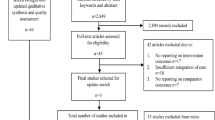Abstract
Aim of the review This review of the international literature aims to assess the evidence and its methodological quality relating to the cost-effectiveness of interventions to improve seamless care focusing on medication. Method Studies were identified by searching Medline, EMBASE, Centre for Reviews and Dissemination databases, Cochrane Database of Systematic Reviews, and EconLit up to March 2011 using search terms related to health economics and to seamless care. To be included, economic evaluations had to explore the costs and consequences of an intervention to improve seamless care focusing on medication as compared with usual care. Methodological quality of studies was assessed by considering perspective; design; source of clinical and economic data; cost and consequence measures; allowance for uncertainty; and incremental analysis. Costs were actualized to 2007 values. Results Eight studies on medication interventions for hospitalized patients in the transition between ambulatory and hospital care were included in the review. A variety of types of medication interventions and target populations have been assessed, but the evidence is limited to one economic evaluation for each particular intervention type and each specific target population. Most studies demonstrated an impact of interventions on compliance and (re)hospitalization rates and costs. The studies did not find an impact on quality of life or symptoms. Economic evaluations suffered from methodological limitations related to the narrow perspective; restriction to health care costs only; exclusion of costs of the intervention; use of intermediate consequence measures; no allowance for uncertainty; and absence of incremental analysis. Conclusion In light of the small number of economic evaluations and their methodological limitations, it is not possible to recommend a specific intervention to improve seamless care focusing on medication on health economic grounds.

Similar content being viewed by others
References
Canadian Society of Hospital Pharmacists and Canadian Pharmacists. In: Proceedings of the seamless care workshop, Ottawa; 1998.
Continuity of care in medication management: review of issues and considerations for pharmacy. Am J Health Syst Pharm. 2005;62(16):1714–1720.
Tam VC, Knowles SR, Cornish PL, Fine N, Marchesano R, Etchells EE. Frequency, type and clinical importance of medication history errors at admission to hospital: a systematic review. CMAJ. 2005;173(5):505–510.
Paulino EI, Bouvy ML, Gastelurrutia MA, Guerreiro M, Buurma H. Drug related problems identified by European community pharmacists in patients discharged from hospital. Pharm World Sci. 2004;26(6):353–60.
Viktil KK, Blix HS. The impact of clinical pharmacists on drug-related problems and clinical outcomes. Basic Clin Pharmacol Toxicol. 2008;102(3):275–80.
Ernst FR, Grizzle AJ. Drug-related morbidity and mortality: updating the cost-of-illness model. J Am Pharm Assoc (Wash). 2001;41(2):192–9.
Johnson JA, Bootman JL. Drug-related morbidity and mortality. A cost-of-illness model. Arch Intern Med. 1995;155(18):1949–1956.
Spinewine A, Foulon V, Claeys C, De Lepeleire J, Chevalier P, Desplenter FA, et al. Seamless care focusing on medication between hospital and home. Brussels; 2010 (Report No.: KCE report 131A).
Drummond M, Sculpher MJ, Torrance GW, O’Brien BJ, Stoddart GL. Methods for the economic evaluation of health care programmes. 3rd ed. Oxford: Oxford University Press; 2005.
Badger N, Mullis S, Butler K, Tucker D. Pharmacist’s intervention for older hospitalized patients. Am J Health Syst Pharm 2007;64(17):1794–1796.
Coleman EA, Parry C, Chalmers S, Min SJ. The care transitions intervention: results of a randomized controlled trial. Arch Intern Med. 2006;166(17):1822–1828.
Smeenk FW, Ament AJ, van Haastregt JC, de Witte LP, Crebolder HF. Cost analysis of transmural home care for terminal cancer patients. Patient Educ Couns. 1998;35(3):201–11.
Stewart S, Vandenbroek AJ, Pearson S, Horowitz JD. Prolonged beneficial effects of a home-based intervention on unplanned readmissions and mortality among patients with congestive heart failure. Arch Intern Med. 1999;159(3):257–261.
Cabezas C, Salvador C, Quadrada D, Bartés A, Boré M, Perea N, et al. Randomized clinical trial of a post discharge pharmaceutical care program versus regular follow-up in patients with heart failure. Farmacia Hospitalaria. 2006;30(6):328–42.
Desplenter FA. Exploring the impact of medication information for psychiatric patients at hospital discharge. Leuven: Katholieke Universiteit Leuven; 2009.
Dudas V, Bookwalter T, Kerr KM, Pantilat SZ. The impact of follow-up telephone calls to patients after hospitalization. Am J Med. 2001;111(9B):26S–30S.
Hugtenburg JG, Borgsteede SD, Beckeringh JJ. Medication review and patient counselling at discharge from the hospital by community pharmacists. Pharm World Sci. 2009.
Jack BW, Chetty VK, Anthony D, Greenwald JL, Sanchez GM, Johnson AE, et al. A reengineered hospital discharge program to decrease rehospitalization: a randomized trial. Ann Intern Med. 2009;150(3):178–187.
Karnon J, Campbell F, Czoski-Murray C. Model-based cost-effectiveness analysis of interventions aimed at preventing medication error at hospital admission (medicines reconciliation). J Eval Clin Pract. 2009;15(2):299–306.
Smith L, McGowan L, Moss-Barclay C, Wheater J, Knass D, Chrystyn H. An investigation of hospital generated pharmaceutical care when patients are discharged home from hospital. Br J Clin Pharmacol. 1997;44(2):163–5.
Karapinar-Carkit F, Borgsteede SD, Zoer J, Siegert C, van TM, Egberts AC, et al. The effect of the COACH program (continuity of appropriate pharmacotherapy, patient counselling and information transfer in healthcare) on readmission rates in a multicultural population of internal medicine patients. BMC Health Serv Res. 2010;10:39.
Funding
Financial support for this research was received from the Belgian Health Care Knowledge Centre, a state-funded research institution.
Conflicts of interest
The authors have no conflicts of interest that are directly relevant to the content of this manuscript.
Author information
Authors and Affiliations
Corresponding author
Rights and permissions
About this article
Cite this article
Simoens, S., Spinewine, A., Foulon, V. et al. Review of the cost-effectiveness of interventions to improve seamless care focusing on medication. Int J Clin Pharm 33, 909–917 (2011). https://doi.org/10.1007/s11096-011-9563-5
Received:
Accepted:
Published:
Issue Date:
DOI: https://doi.org/10.1007/s11096-011-9563-5




